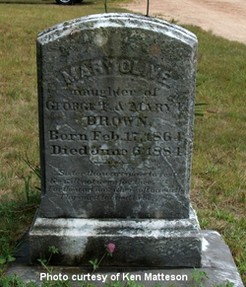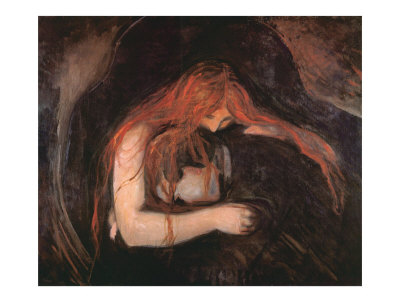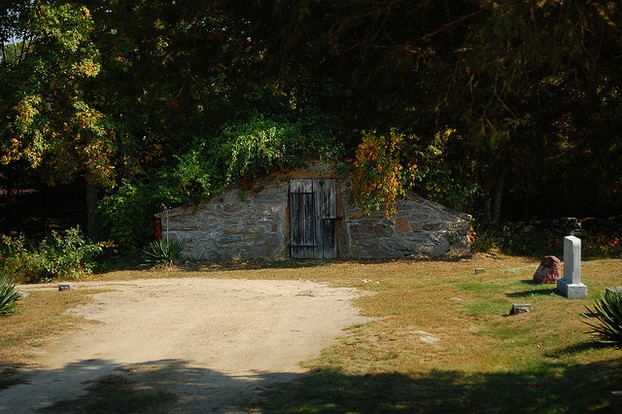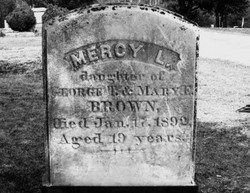 Mary Eliza Brown went first. The stalwart mother of the family slowly weakened and died in December 1883.
Mary Eliza Brown went first. The stalwart mother of the family slowly weakened and died in December 1883.
The burden of cooking, washing, cleaning and caring for her siblings fell to the eldest daughter, Mary Olive. She was only a teenager herself, but quietly got on with what needed to be done. That was what she was like.
Those in the community remembered her as a modest, shy person. Her compassion was noted, as was her gentle demeanor.
Yet even these attributes couldn't save her. They were supposed to. God should have protected people such as her.
Maybe it had been the fact that her family were not church-goers. She didn't even enter a chapel until a month before she died. But that wasn't too unusual. In the remote agricultural districts of Rhode Island, it could be a long trek to make it to a Sunday service. There was always too much to do around the farm. The majority of those families could be unassumingly Christian at home without the intervention of a preacher.
Mary Olive Brown was already showing signs of wilting before her mother had even passed. As she labored to console her bereft young brother and sisters - and support her father as she could - she grew ever more pale.
The cough came. It grew gradually from an occasional spasm into an almost constant hacking. Her whole body shook under it. Handkerchiefs moved from spotted to covered with blood. Her lungs were retching the stuff.
It was more desperation than holy conviction, which saw Mary Olive rise from her bed and take the long journey to the chapel. She sat in its congregation for less than a month, then she was too ill to make it there and back. Christian visitors came to her instead. They prayed over her bedside.
Mary Olive Brown passed her twentieth birthday fading under her symptoms, but she wouldn't see another. She died on June 6th 1884, less than seven months after her mother, and she was buried alongside her.
Everything died down then. George Brown must have watched over his remaining children with utter anxiety. But Edwin, Annie, Mercy, Hattie, Jennie and Myra all seemed healthy and well. Devastated by their losses, but physically fine.
Until 1891, when the symptoms reappeared with a vengeance.





 Mary Eliza Brown went first. The stalwart mother of the family slowly weakened and died in December 1883.
Mary Eliza Brown went first. The stalwart mother of the family slowly weakened and died in December 1883. 








 It was freezing inside that little stone building in Chestnut Hill Cemetery. Outside, the New England winter dragged on into March. The snow had gone but the frost lingered. Even with the walls of the crypt shielding the icy wind, it was still cold.
It was freezing inside that little stone building in Chestnut Hill Cemetery. Outside, the New England winter dragged on into March. The snow had gone but the frost lingered. Even with the walls of the crypt shielding the icy wind, it was still cold.


 It's perhaps inevitable that such a story couldn't end there. Even today, her grave is visited and offerings left.
It's perhaps inevitable that such a story couldn't end there. Even today, her grave is visited and offerings left.



 St Tydecho's Churches in West Waleson 09/03/2014
St Tydecho's Churches in West Waleson 09/03/2014
 Goodies for an Outlander Premiere Partyon 03/06/2015
Goodies for an Outlander Premiere Partyon 03/06/2015
 Holocaust Memorial Day Interview with Rainer Höss, Grandson of Rudolf Architect of Auschwitzon 01/24/2015
Holocaust Memorial Day Interview with Rainer Höss, Grandson of Rudolf Architect of Auschwitzon 01/24/2015
 Romantic Valentine Gifts for an Outlander Fanon 01/16/2015
Romantic Valentine Gifts for an Outlander Fanon 01/16/2015



Comments
Thank you. I really do feel for the poor people in that situation. Unfortunately, it was one repeated so many times in history.
I really felt for the family. They were in such desperation to even try it, when they didn't even believe in vampires. Poor people.
My goodness. That is scary. The worst is that it didn't help. Nice ending though that she is sort of a good spirit now.
It always does, doesn't it? It allows us to speculate endlessly about the possibilities. What's your take on it?
This is truly fascinating stuff, Jo. Truth really is stranger than fiction. Oh, and I'm with Ymunro, the fact that the truth is still unknown makes it all the more appealing!
I thoroughly enjoyed researching this one. It's not a story which I was familiar with until a few days ago.
What a fascinating article. Love the mystery of the unknown.
One theory is that the body moves anyway after death. Gases escape and muscles jerk or tendons loosen. It can cause corpses to sit up, so it may well have made her appear to turn over.
Or she was buried alive. Or she was a vampire. We may never know.